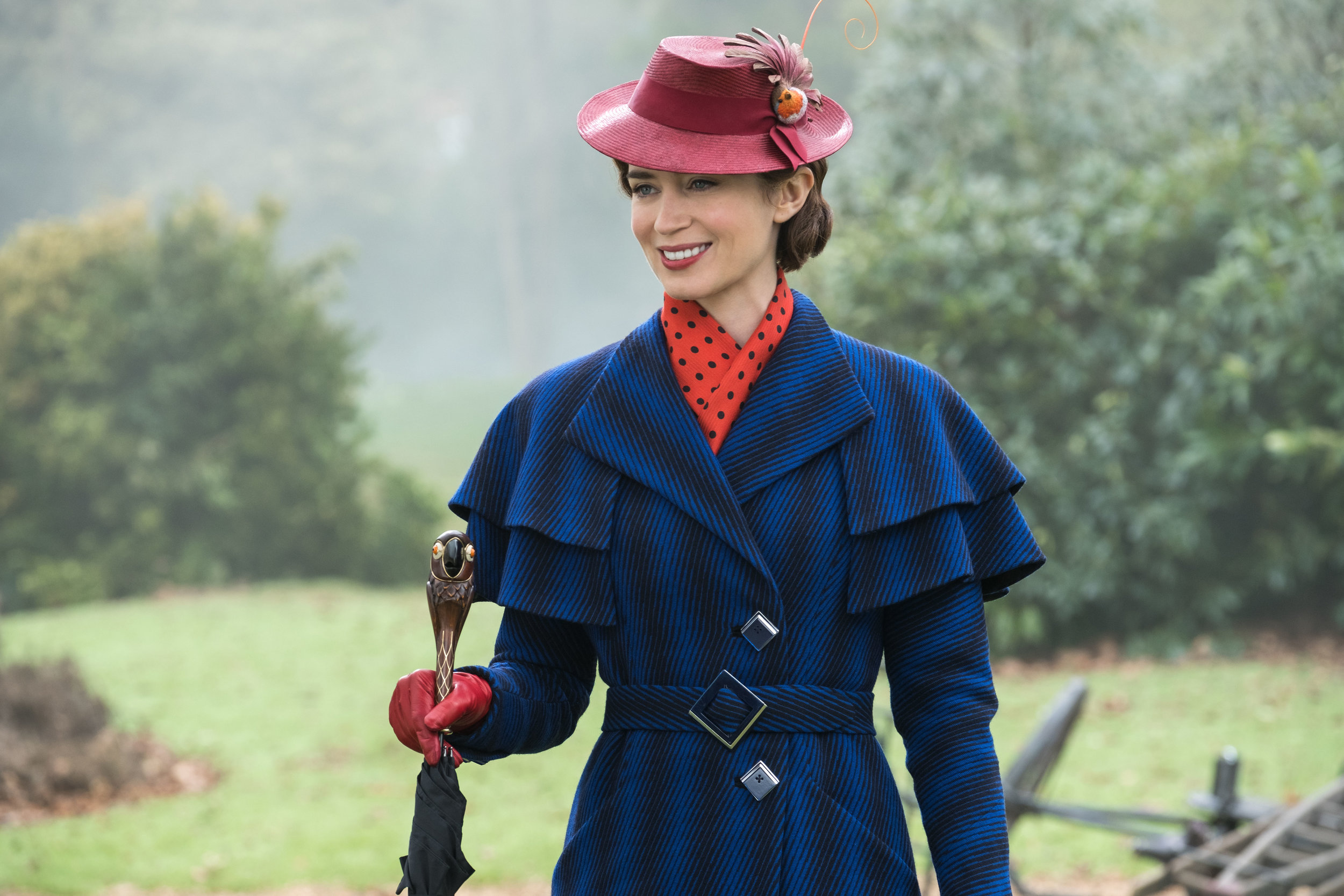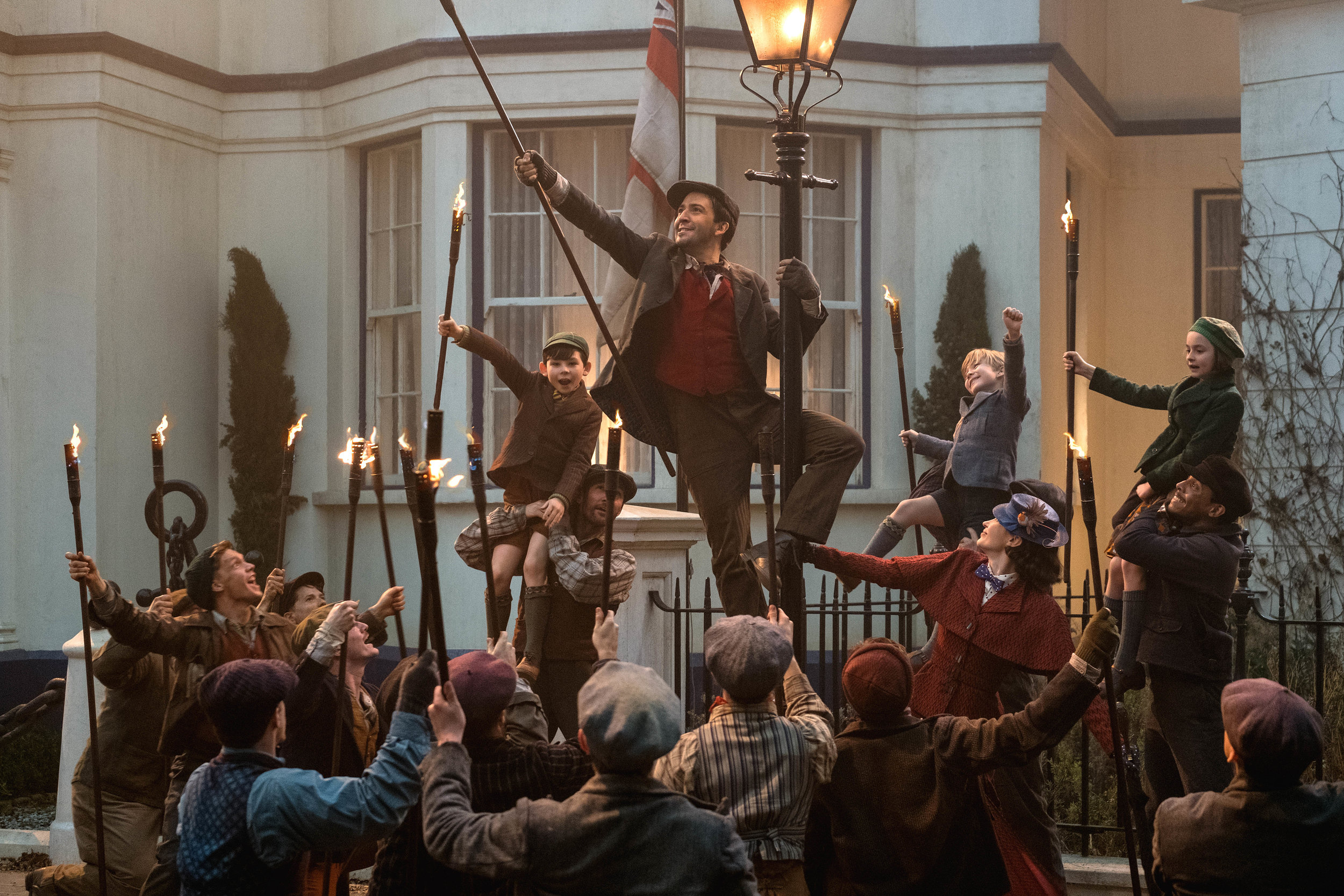'Mary Poppins Returns': A couple granules shy of a spoonful
Emily Blunt stars in “Mary Poppins Returns.” (Photo courtesy Disney)
A kite carries with it some airy symbolic profundity. How often do you hold onto something by a string at perfect tautness so it doesn’t fly away, but also doesn’t crash into the ground? A child’s innocence requires a delicate handling of the sort, and is the lifeblood of “Mary Poppins,” the 1964 Disney classic that’s not only considered one of the greatest movie musicals of all time, but also one of the greatest children’s films ever.
Julie Andrews’ beloved performance as the title character, a batch of delightful songs and an enchanting display of special effects are the catalyst for the 1964 film’s impeccable playfulness, which the new sequel attempts to replicate, with middling success. Of course, nobody expects “Mary Poppins Returns” to be a gritty, modern realization in which chimney sweeps regularly die of toxic ash inhalation and their attempts to unionize are squashed by cruel corporate entities. Nor would it make Ms. Poppins subject to an origin story detailing her childhood as a wartime refugee who learned to take care of children and clean houses as subjugate to a fascist higher-up who brutalized her.
My apologies for dispatching this imagery. I blame dark times, and perhaps the detachment that comes when one doesn’t harbor warm childhood memories of watching the original picture, but still understands its timeless appeal. (Mine wasn’t a Disney Family.) So maybe the flighty gaiety of “Mary Poppins Returns” is the sweet thing we need to help swallow the bitter things of our day. (There’s a metaphor here somewhere, but it’s lost to me.) No, the franchise remains benign, for better (sweet nostalgia) or for worse (nothing new here), and wields its whimsy like a cudgel. You. Will. Submit. To. The whimsy. Or stew in the sad and rancid gravies of your own misery.
My instinct to resist was sufficiently seduced by the wonderfully talented Emily Blunt, who plays Mary Poppins with the perfect prim-and-proper eye twinkle, as demanded by the role. “Pish-posh,” she tuts. “Spit-spot,” she asserts. Your eyes will roll, but so do Blunt’s. This brings us back to earlier blatherings about a kite, because Poppins arrives on the scene when a boy loses his fluttering plaything-slash-plot-device in a storm wind, and she floats down, fancy as ever, kite in hand, to save him and his siblings from becoming Les Miserables because their father forgot to pay the mortgage and is facing the loss of their London home.
“Mary Poppins Returns” (Photo courtesy Disney)
Said father is Michael Banks (Ben Whishaw), one of the children from the original movie, all grown up now. He’s a widower fighting his way through an economic downturn referred to as the Great Slump. He still lives in the house he and his sister, Jane (Emily Mortimer), grew up in. The Banks family’s misfortune begins with the explosion of some plumbing, and then some bankers knocking on the door with bad news. They carry with them a repossession notice, the product of late payments, which Michael can make up quickly, but the bank is being a bit of a bugger about it, and demands the full amount of the loan in five days.
Yes, it’s that old chestnut, the lose-the-house plot. Have you ever tried pleading with an immovable credit card company when you make your payment one measly day late and are still slapped with a $38 fee? It’s like that, except with more Heavily Mustached Colin Firth, playing the villainous head banker who, if the film was set in 2018 instead of the 1930s, would want to gentrify the locale and turn it into condos, an upscale taco shop and a hipster throwback haberdashery.
Michael is so preoccupied with Adult Things, he mostly just shrugs when the flying nanny-housemaid arrives with fantastical fancy to polish the banister and give the kids a bath, which they need after a gambol in the mud. (And if you wonder when and how exactly the plumbing got fixed, you’re just a cad who refuses to believe in magic.) The children -- well, I recall there being three of them, of small, medium and large size. They’re played by Pixie Davies, Nathaniel Saleh and Joel Dawson, and are barely characters, just analogs for our empathy (they’re sad because their mother is dead) and wonder (the bath is bottomless, leading them under the sea for some adventure and singing to distract them from their worries).
Notably, none of these people is the first human we see in the movie. That would be Lin-Manuel Miranda, the Broadway superstar of “Hamilton” fame, here playing Jack, a lamplighter or, in the parlance of our times, an urban illumination maintenance technician. He sings and dances and crap, invoking Dick Van Dyke’s flue and funnel custodial engineer from the original movie. Miranda gets a ton of screen time -- does he rap? Indeed, my friends, indeed -- despite having no significance to the plot whatsoever. The character exists simply because Lin-Manuel Miranda is playing him, and the songs and choreography in which he participates exist simply because Lin-Manuel Miranda is performing them.
Director Rob Marshall (“Chicago”) doesn’t shy away from complicated, effects-laden sequences. A highlight is a trip to the land dubbed “China” because it’s on the side of a fancy bowl; it blends live action and 2-D hand-drawn cartoons, a throwback to classic Disney cel animation, which at least looks authentic, even though I’d bet you six crumpets and some toast that a computer was used somewhere in its making. The sequence functionally employs some entertaining Jack/Poppins song and dance, builds to a chase and a frenzy, then Marshall doesn’t know how to get out of it, so he opts for some abrupt nonsense -- much more abrupt than the rest of the nonsense here, which often seems like something the Coen Bros. would satirize.
There is more. How often do you get 10 paragraphs into a review before Meryl Streep is mentioned? She turns up for a musical sequence that wouldn’t exist if Meryl Streep didn’t have an open spot in her schedule. The film stretches past two hours, and the musical numbers tend to meander for a verse and chorus too long, and a significant portion of the third act seems to forget that Mary Poppins is the title character and does, indeed, exist. In fact, while we’re here, what exactly is Mary Poppins? A child psychologist? A witch? Angel, demon or demigod? A manifestation of wholesome, virginal whimsy in human form? Spit-spot. That must be it.
P.S. The movie is fine. It’s Christmastime. Go see it.
‘Mary Poppins Returns’
★★½
MPAA rating: PG for some mild thematic elements and brief actiono
Director: Rob Marshall
Cast: Emily Blunt, Lin-Manuel Miranda, Ben Whishaw, Emily Mortimer
Run time: 130 minutes




